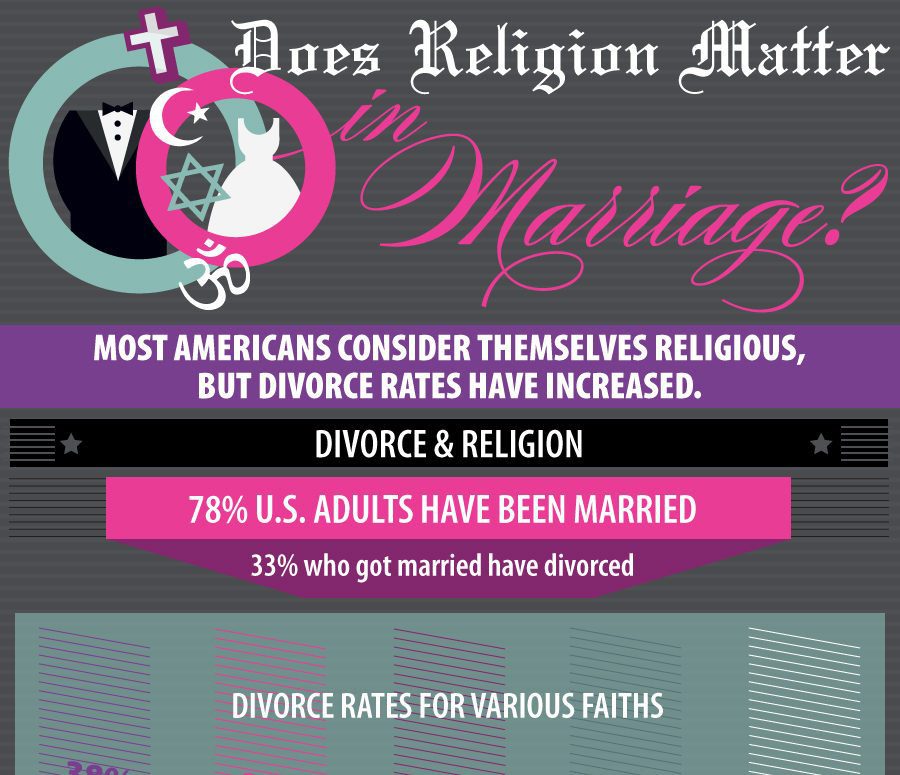The U.S. is a significantly religious country in terms of how many people believe in God and give a religious affiliation – which should mean that marriage is an important part of life to most people, whether they marry once, many times or never. Unfortunately, some marriages do not last happily ever after, as witnessed by increased divorce rates in the past 40-plus years.
Divorce has been around since before the founding of the United States of America. However, divorce laws are dictated by each state, so some states have historically limited the conditions for divorce. It wasn’t until 1970 that the divorce process in the USA arguably got easier, when California started allowing no-fault divorces and other states eventually did the same.
Religion, Marriage, Divorce: The Numbers
While Americans as a wholly mostly consider themselves religious, divorce rates have increased regardless. Here are some stats on marriage, divorce, and religion.
Note: Because of federal laws, the US Census Bureau does not have mandatory questions on religious affiliations. As such, there is no 100% comprehensive report of religious affiliation for US citizens and residents and thus no complete study of the populace on the inter-significance of religion and marriage. However, there have been other surveys with varying sample sizes conducted specifically to determine religious affiliation and any connection to marriage and divorce. The stats listed below are from these various surveys.
Religion in the USA
PewResearch reported on a study of 35,556 Americans (18 or older) conducted by PSRAI (Princeton Survey Research Associates International) in 2007 (published 2008), entitled the “U.S. Religious Landscape Survey,” providing the following summary:
- 92% of adults surveyed believed in God.
- 63% of those surveyed said they believed that Scripture is the word of God.
- 78.4% of those surveyed indicated they were Christian. This breaks down further to 51.3% of those surveyed being some denomination of Protestant, 26.3% Catholic, 1.7% Mormon, 0.7% Jehovah’s Witness, 0.6% Orthodox, 0.3% “Other Christian.”
- Approximately 4.7% of adults surveyed indicated they were of other religions, with 1.7% Jewish, 0.7% Buddhist, 0.6% Muslim, 0.4% Hindu, less than 0.3% “Other world religions,” and 1.2% “Other faiths” (which includes Unitarians).
- 16.1% of those surveyed said they were unaffiliated, but 12.1% indicated “Nothing in particular” (which breaks down to 6.3% Secular unaffiliated, 5.8% Religious unaffiliated). As well, there were 1.6% Atheist and 2.4% Agnostic.
- 0.8% of those surveyed refused to answer or indicated they didn’t know their religious affiliation.
- Paradoxically, 21% of self-described atheists said “they believe in God or a universal spirit”. For self-described agnostics, this figure was 55%. Author Steven Waldman explains that this conflicting info is because “… Atheism has become a cultural designation, rather than a theological statement. Some are likely declaring themselves atheists as a statement of hostility to organized religion, rather than to God.”
Marriage in the USA
U.S. Census Bureau figures for 2010 show the following marriage demographic summary:
- There were approximately 60.4M (60,384,000) married couples (with or without children).
- 66.4% of U.S. households were family households, which breaks down further into roughly (errors due to rounding): 20.2% Married couples with children; 28.2 Married couples without children; 9.6% Single parents with children; 8.5% Other family. This is a steady decline from 1940: 90.0% in 1940, 85.1% in 1960, 73.7% in 1980, 68.1% in 2000.
- 33.6% of U.S. households are “Nonfamily Households,” consisting of “One person” or “Other nonfamily” homes — an increase from 1940′s 10.0%. (15.1% in 1960, 26.4% in 1980, 31.9% in 2000.)
- The percentage of married households to total households fell from about 53.6% in 2000 to 48.4% in 2010. For 1990: 55.2%, 1980: 60.9%, 1960: 74.8%, 1940: 76.3%.
- 5.4M households had interracial or interethnic married-couple households in the U.S. in 2010. This represents 9.5% of all married-couple households — an increase from the 7.4% figure recorded in the 2000 Census.
- The Census Bureau has 64 different combinations for describing interracial or interethnic couples. Of these combinations, 7 groups made up 94% of all interracial / interethnic couples. (More details on these definitions can be found at http://www.census.gov/population/www/cen2010/briefs/cph-t-4.html)
- The largest of these groups represents 2.02M (2,020,825) interracial/ interethnic couples categorized as “Non-Hispanic White/Hispanic (any race)” — with the top 5 counties represented by the states AZ (1 county), NM (3 counties) and CO (1 county).
Divorce in the USA
- In 1970, California became the first U.S. state to offer no-fault divorce, thanks to a bill signed in 1969 by then Governor Ronald Reagan — who divorced his first wife, Jane Wyman — signed into law. Reagan claimed later that his signing the bill was a political mistake, but most other states followed suit.
- New York state did not have no-fault divorce until Aug 2010.
- The national divorce rate in 1980 (22.6 divorces per 1,0000 married women) was nearly 2.5 times the 1960 rate (9.2 divorces per 1,000 married women) — an increase of 145.65%.
- Approximately 20% of couples married in 1950 ended up divorced — affecting about 11% of children born to married parents in the 1950s.
- Approximately 50% of couples married in 1970 ended up divorced — affecting about 50% of children born to married parents in the 1970s.
- Sociologist Paul Amato estimated that divorce affects children in multiple ways, including causing them to have to repeat grades, getting suspended, being delinquent, getting therapy, and attempting suicide. Amato feels that if family stability now was about the same as in 1960, there would be as much as 70,000 fewer suicide attempts yearly by children of divorced parents — as well a significant reductions in the above issues. (Amato’s findings are contested by others who feel the problems exhibited in children stem from pre-divorce events, not necessarily divorce itself.)
- 61% of 1,600-person membership of AAML (American Association of Matrimonial Lawyers) said that they have seen increases in “gray divorce” (over-50 couples married long-term), according to an online poll conducted in 2013.
- About 1 in 4 people who got divorced in 2009 were 50 or older, compared to about 1 in 10 people in 1990 — according to a 2012 Bowling Green State University study based partly on U.S. Census Bureau data (2009 American Community Survey; 1990 U.S. Vital Statistics Report).
- Over 600K people 50 or older got divorced in 2009, according to the same Bowling Green State University study.
- Couples in Red-states (predominantly Republican) are 27% more likely to get-divorced than blue-state (predominantly Democrat) couples. This is possibly due to younger median ages for marriage in Red-states — a factor that increaes the risk of divorce.
- On average, a person is 40% more likely to get divorced if their parents did; 91% more likely if their parents remarried (to other people).
- Couples who argue about money apparently have a 30% greater chance ending up divorced than couples who argue less.
Common Reasons for Divorces
According to an NFI (National Fatherhood Initiative) survey of divorced American couples, the most common reasons for their divorce include the following:
- 73% — Lack of commitment. In addition, 35% of men and 21% of women indicated they should have “worked harder in the marriage.” This is sometimes characterized by selfishness and/or lack of communication by one or both parties.
- 56% — Too much arguing.
- 55% — Infidelity.
- 46% — Married too young.
- 45% — Unrealistic expectations.
- 44% — Inequality within the marriage, such as balance of responsibility.
- 41% — Not prepared for marital responsibilities.
- 29% — Domestic abuse and violence.
![Religion, Marriage, Divorce: The Numbers [Infographic] 1 Religion-Marriage-Infographic](https://eadn-wc03-10628962.nxedge.io/wp-content/uploads/2014/01/Religion-Marriage-Infographic.jpg)







